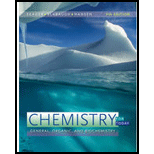
Concept explainers
(a)
Interpretation:
Dextrose is to be identified as a monosaccharide or a disaccharide. If it is a disaccharide, the individual monosaccharide components for dextrose are to be stated.
Concept introduction:
Monosaccharides are the small units of simple sugars. Disaccharides are formed by two units of monosaccharides. Polysaccharides are made up of small units of monosaccharides. These small units are joined together by glycoside linkage.
(b)
Interpretation:
Fructose is to be identified as a monosaccharide or a disaccharide. If it is a disaccharide, the individual monosaccharide components for fructose are to be stated.
Concept introduction:
Monosaccharides are the small units of simple sugars. Disaccharides are formed by two units of monosaccharides. Polysaccharides are made up of small units of monosaccharides. These small units are joined together by glycoside linkage.
(c)
Interpretation:
Sucrose is to be identified as a monosaccharide or a disaccharide. If it is a disaccharide, the individual monosaccharide components for dextrose are to be stated.
Concept introduction:
Monosaccharides are the small units of simple sugars. Disaccharides are formed by two units of monosaccharides. Polysaccharides are made up of small units of monosaccharides. These small units are joined together by glycoside linkage.
(d)
Interpretation:
Maltose is to be identified as a monosaccharide or a disaccharide. If it is a disaccharide, the individual monosaccharide components for maltose are to be stated.
Concept introduction:
Monosaccharides are the small units of simple sugars. Disaccharides are formed by two units of monosaccharides. Polysaccharides are made up of small units of monosaccharides. These small units are joined together by glycoside linkage.
(e)
Interpretation:
Lactose is to be identified as a monosaccharide or a disaccharide. If it is a disaccharide, the individual monosaccharide components for lactose are to be stated.
Concept introduction:
Monosaccharides are the small units of simple sugars. Disaccharides are formed by two units of monosaccharides. Polysaccharides are made up of small units of monosaccharides. These small units are joined together by glycoside linkage.
(f)
Interpretation:
Ribose is to be identified as a monosaccharide or a disaccharide. If it is a disaccharide, the individual monosaccharide components for ribose are to be stated.
Concept introduction:
Monosaccharides are the small units of simple sugars. Disaccharides are formed by two units of monosaccharides. Polysaccharides are made up of small units of monosaccharides. These small units are joined together by glycoside linkage.
Trending nowThis is a popular solution!

Chapter 17 Solutions
Chemistry For Today: General, Organic, And Biochemistry, Loose-leaf Version
- Draw a tetramer of this alternating copolymer.arrow_forwardH I T H HH H -H C. H- Identify and select all structures below that represent a constitutional isomer(s) of the compound shown above. H- H CIH H H H HHHH H H 0 ·H H– 冊 CH CHI HH C- H- H H- H H A. H H C H H- -H HH H B. H- -H D. H H H H • H -H E. -H H H HICH T HHH F. H-arrow_forwardPolylactic acid (shown below) is a biodegradable polymer used for food packaging. Identify the monomer(s) used in the production of this polymer using a condensation process.arrow_forward
- Draw the product of the reaction shown below. Ignore small byproducts that would evaporate pleasearrow_forwardPoly(ethylene adipate) is a biodegradable polyester (shown below). Identify the type of polymerization process used in the production of this polymer.arrow_forwardPolymers may be composed of thousands of monomers. draw two repeat units(dimer) of the polymer formed in this reaction. assume there are hydrogen atoms on the two ends of the dimer. ignore inorganic byproducts pleasearrow_forward
- Draw the product of the reaction shown below. Use a dash or wedge bond to indicate stereochemistry of substituents on asymmetric centers, Ignore inorganic byproductsarrow_forwardDraw the product of this reaction please. Ignore inorganic byproductsarrow_forwardOne of the pi molecular orbitals of 1,3-butadiene (CH2=CHCH=CH2) is shown below. Please identify the number of nodal planes perpendicular to the bonding axisarrow_forward
- Draw the monomers required to synthesize this condensation polymer please.arrow_forwardProvide the correct systematic name for the compound shown here. Please take into account the keyboard options belowarrow_forwardcurved arrows are used to illustrate the flow of electrons. using the provided starting and product structures, draw the curved electron-pushing arrows for the following reaction or mechanistic step(s)arrow_forward
- Chemistry: Matter and ChangeChemistryISBN:9780078746376Author:Dinah Zike, Laurel Dingrando, Nicholas Hainen, Cheryl WistromPublisher:Glencoe/McGraw-Hill School Pub Co
 Chemistry for Today: General, Organic, and Bioche...ChemistryISBN:9781305960060Author:Spencer L. Seager, Michael R. Slabaugh, Maren S. HansenPublisher:Cengage Learning
Chemistry for Today: General, Organic, and Bioche...ChemistryISBN:9781305960060Author:Spencer L. Seager, Michael R. Slabaugh, Maren S. HansenPublisher:Cengage Learning ChemistryChemistryISBN:9781305957404Author:Steven S. Zumdahl, Susan A. Zumdahl, Donald J. DeCostePublisher:Cengage Learning
ChemistryChemistryISBN:9781305957404Author:Steven S. Zumdahl, Susan A. Zumdahl, Donald J. DeCostePublisher:Cengage Learning  Chemistry: An Atoms First ApproachChemistryISBN:9781305079243Author:Steven S. Zumdahl, Susan A. ZumdahlPublisher:Cengage Learning
Chemistry: An Atoms First ApproachChemistryISBN:9781305079243Author:Steven S. Zumdahl, Susan A. ZumdahlPublisher:Cengage Learning
 World of Chemistry, 3rd editionChemistryISBN:9781133109655Author:Steven S. Zumdahl, Susan L. Zumdahl, Donald J. DeCostePublisher:Brooks / Cole / Cengage Learning
World of Chemistry, 3rd editionChemistryISBN:9781133109655Author:Steven S. Zumdahl, Susan L. Zumdahl, Donald J. DeCostePublisher:Brooks / Cole / Cengage Learning





